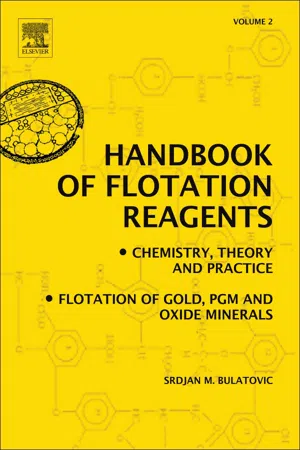
Handbook of Flotation Reagents: Chemistry, Theory and Practice
Volume 2: Flotation of Gold, PGM and Oxide Minerals
- 230 pages
- English
- ePUB (mobile friendly)
- Available on iOS & Android
Handbook of Flotation Reagents: Chemistry, Theory and Practice
Volume 2: Flotation of Gold, PGM and Oxide Minerals
About This Book
Handbook of Flotation Reagents: Chemistry, Theory and Practice: Flotation of Gold, PGM and Oxide Minerals, Volume 2 focuses on the theory, practice, and chemistry of flotation of gold, platinum group minerals (PGMs), and the major oxide minerals, along with rare earths. It examines separation methods whose effectiveness is limited when using conventional treatment processes and considers commercial plant practices for most oxide minerals, such as pyrochlore-containing ores, copper cobalt ores, zinc ores, tin ores, and tantalum/niobium ores. It discusses the geology and mineralogy of gold, PGMs, and oxide minerals, as well as reagent and flotation practices in beneficiation. The book also looks at the factors affecting the floatability of gold minerals and describes PGM-dominated deposits such as Morensky-type deposits, hydrothermal deposits, and placer deposits. In addition, case studies of flotation and beneficiation in countries such as Canada, Africa, Russia, Chile, and Saudi Arabia are presented. This book will be useful to researchers, university students, and professors, as well as mineral processors faced with the problem of beneficiation of difficult-to-treat ores.
- Looks at the theoretical aspects of flotation reagents
- Examines the practical aspects of using chemical reagents in operating plants
- Provides guidelines for researchers and engineers involved in process design and development
Frequently asked questions
Information
Index
- AAC10, for tantalum/niobium and zircon separation, 147, 148t
- Acid pretreatment, for ilmenite flotation, 178, 179f
- Acidified silica/AQ55D, for apatite-ilmenite ore beneficiation, 189
- Acintols, for Indian beach sand flotation, 165, 166t
- Acrylate, for oxide zinc ore flotation, 82, 82t
- Alaskan-type deposits, of PGM, 22
- Alkyl hydroxamate, for yttrium group of REOE beneficiation, 156, 156–157, 156f
- Alluvial deposits, of PGM, 22
- Aluminum sulphate, as tin ore collector, 102
- Amines
- for fluorite flotation, 163–164
- for oxide zinc ore flotation, 72, 72t, 81, 81t
- for pyrochlore flotation, in carbonatite ores, 116, 116t
- for tantalite-columbite flotation, 130, 130f
- for tantalum/niobium recovery
- in Ghurayyah ore, 136, 136t
- in Malawi, Africa ores, 140, 141f
-
-
- Anglesite, flotation of, 70, 71f
- Anorthositic deposits, of titanium, 177
- Antimony ore, flotation of
- gold-antimony ores, 10, 11t
- gold-containing, 5, 6f, 6t
-
- Apatite-ilmenite ores, beneficiation of, 186, 187f, 188f, 189f, 190f, 191t
- collectors for, 187, 188f
-
- AQ4, in niobium recovery, 121, 121t, 122f
- Armac C, for oxide zinc ore flotation, 72t, 73
- Arsenical gold ores, flotation of, 11, 12f
- Arsenopyrite, pyrite separation from, 11–12, 12f
- Arsonic acid collector, for tin ores, 93, 93f, 94f
- Atacamate, flotation of, 51
- Azurite, flotation of, 51
- BAA.see Benzyl arsonic acid
- Barite, flotation of, 162
- Barite-calcite gangue, for mixed sulphide oxide lead zinc ore beneficiation, 77, 77t, 78t
- Barite-fluorite ores, bastnaesite flotation in, 154, 162, 162t, 163f, 164t
- Barium chlorite, for barite flotation, 162
- Barium sulfide (BaS), for oxide lead ore, 70
- BaS.see Barium sulfide
- Base metal sulphide ores, gold flotation from, 13, 14f, 14t
- Bastnaesite, 151, 152t, 153
- flotation of, 153, 154, 153f, 154f, 155f, 1...
-
Table of contents
- Cover
- Title Page
- Copyright
- Table of Contents
- Introduction
- 17: Flotation of Gold Ores
- 18: Flotation of Platinum Group Metal Ores
- 19: Flotation of Oxide Copper and Copper Cobalt Ores
- 20: Flotation of Mixed Lead Zinc Sulphide Oxide and Oxide Lead and Zinc Ores
- 21: Flotation of Tin Minerals
- 22: Flotation of Niobium
- 23: Flotation of Tantalum/Niobium Ores
- 24: Flotation of REO Minerals
- 25: Flotation of Titanium Minerals
- Index